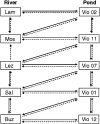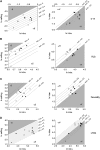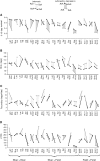The different sources of variation in inbreeding depression, heterosis and outbreeding depression in a metapopulation of Physa acuta
- PMID: 18791233
- PMCID: PMC2581960
- DOI: 10.1534/genetics.108.092718
The different sources of variation in inbreeding depression, heterosis and outbreeding depression in a metapopulation of Physa acuta
Abstract
Understanding how parental distance affects offspring fitness, i.e., the effects of inbreeding and outbreeding in natural populations, is a major goal in evolutionary biology. While inbreeding is often associated with fitness reduction (inbreeding depression), interpopulation outcrossing may have either positive (heterosis) or negative (outbreeding depression) effects. Within a metapopulation, all phenomena may occur with various intensities depending on the focal population (especially its effective size) and the trait studied. However, little is known about interpopulation variation at this scale. We here examine variation in inbreeding depression, heterosis, and outbreeding depression on life-history traits across a full-life cycle, within a metapopulation of the hermaphroditic snail Physa acuta. We show that all three phenomena can co-occur at this scale, although they are not always expressed on the same traits. A large variation in inbreeding depression, heterosis, and outbreeding depression is observed among local populations. We provide evidence that, as expected from theory, small and isolated populations enjoy higher heterosis upon outcrossing than do large, open populations. These results emphasize the need for an integrated theory accounting for the effects of both deleterious mutations and genetic incompatibilities within metapopulations and to take into account the variability of the focal population to understand the genetic consequences of inbreeding and outbreeding at this scale.
Figures




References
-
- Andersen, D. H., C. Pertoldi, V. Scali and V. Loeschcke, 2002. Intraspecific hybridization, developmental stability and fitness in Drosophila mercatorum. Evol. Ecol. Res. 4 603–621.
-
- Aspi, J., 2000. Inbreeding and outbreeding depression in male courtship song characters in Drosophila montana. Heredity 84 273–282. - PubMed
-
- Aspi, J., E. Roininen, M. Ruokonen, I. Kojola and C. Vila, 2006. Genetic diversity, population structure, effective population size and demographic history of the Finnish wolf population. Mol. Ecol. 15 1561–1576. - PubMed
-
- Bataillon, T., and M. Kirkpatrick, 2000. Inbreeding depression due to mildly deleterious mutations in finite populations: size does matter. Genet. Res. 75 75–81. - PubMed
-
- Bierne, N., T. Lenormand, F. Bonhomme and P. David, 2002. Deleterious mutations in a hybrid zone: Can mutational load decrease the barrier to gene flow? Genet. Res. 80 197–204. - PubMed
Publication types
MeSH terms
Substances
LinkOut - more resources
Full Text Sources
Research Materials

